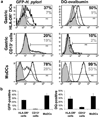Human primary gastric dendritic cells induce a Th1 response to H. pylori
- PMID: 20237463
- PMCID: PMC3683837
- DOI: 10.1038/mi.2010.10
Human primary gastric dendritic cells induce a Th1 response to H. pylori
Abstract
Adaptive CD4 T-cell responses are important in the pathogenesis of chronic Helicobacter pylori gastritis. However, the gastric antigen-presenting cells that induce these responses have not yet been identified. Here we show that dendritic cells (DCs) are present in the gastric mucosa of healthy subjects and are more prevalent and more activated in the gastric mucosa of H. pylori-infected subjects. H. pylori induced gastric DCs isolated from noninfected subjects to express increased levels of CD11c, CD86 and CD83, and to secrete proinflammatory cytokines, particularly interleukin (IL)-6 and IL-8. Importantly, gastric DCs pulsed with live H. pylori, but not control DCs, mediated T-cell secretion of interferon-gamma. The ability of H. pylori to induce gastric DC maturation and stimulate gastric DC activation of Th1 cells implicates gastric DCs as initiators of the immune response to H. pylori.
Conflict of interest statement
The authors declared no conflicts of interest.
Figures






Similar articles
-
Helicobacter pylori stimulates dendritic cells to induce interleukin-17 expression from CD4+ T lymphocytes.Infect Immun. 2010 Feb;78(2):845-53. doi: 10.1128/IAI.00524-09. Epub 2009 Nov 16. Infect Immun. 2010. PMID: 19917709 Free PMC article.
-
Involvement of myeloid dendritic cells in the development of gastric secondary lymphoid follicles in Helicobacter pylori-infected neonatally thymectomized BALB/c mice.Infect Immun. 2003 Apr;71(4):2153-62. doi: 10.1128/IAI.71.4.2153-2162.2003. Infect Immun. 2003. PMID: 12654837 Free PMC article.
-
Chronic exposure to Helicobacter pylori impairs dendritic cell function and inhibits Th1 development.Infect Immun. 2007 Feb;75(2):810-9. doi: 10.1128/IAI.00228-06. Epub 2006 Nov 13. Infect Immun. 2007. PMID: 17101659 Free PMC article.
-
Dendritic cell function in the host response to Helicobacter pylori infection of the gastric mucosa.Pathog Dis. 2013 Feb;67(1):46-53. doi: 10.1111/2049-632X.12014. Epub 2013 Jan 22. Pathog Dis. 2013. PMID: 23620119 Review.
-
The role of T helper 1-cell response in Helicobacter pylori-infection.Microb Pathog. 2018 Oct;123:1-8. doi: 10.1016/j.micpath.2018.06.033. Epub 2018 Jun 21. Microb Pathog. 2018. PMID: 29936093 Review.
Cited by
-
Gastrointestinal cancer resistance to treatment: the role of microbiota.Infect Agent Cancer. 2024 Oct 5;19(1):50. doi: 10.1186/s13027-024-00605-3. Infect Agent Cancer. 2024. PMID: 39369252 Free PMC article. Review.
-
Comparative Immune Response in Children and Adults with H. pylori Infection.J Immunol Res. 2015;2015:315957. doi: 10.1155/2015/315957. Epub 2015 Oct 1. J Immunol Res. 2015. PMID: 26495322 Free PMC article. Review.
-
Microbial biofilms and gastrointestinal diseases.Pathog Dis. 2013 Feb;67(1):25-38. doi: 10.1111/2049-632X.12020. Epub 2013 Jan 29. Pathog Dis. 2013. PMID: 23620117 Free PMC article. Review.
-
The Role of Gastric Mucosal Immunity in Gastric Diseases.J Immunol Res. 2020 Jul 24;2020:7927054. doi: 10.1155/2020/7927054. eCollection 2020. J Immunol Res. 2020. PMID: 32775468 Free PMC article. Review.
-
Cytokines, cytokine gene polymorphisms and Helicobacter pylori infection: friend or foe?World J Gastroenterol. 2014 May 14;20(18):5235-43. doi: 10.3748/wjg.v20.i18.5235. World J Gastroenterol. 2014. PMID: 24833853 Free PMC article. Review.
References
-
- Parkin DM. The global health burden of infection-associated cancers in the year 2002. Int. J. Cancer. 2006;118:3030–3044. - PubMed
-
- Peek RM, Jr, Blaser MJ. Helicobacter pylori and gastrointestinal tract adenocarcinomas. Nat. Rev. Cancer. 2002;2:28–37. - PubMed
-
- Bamford KB, et al. Lymphocytes in the human gastric mucosa during Helicobacter pylori have a T helper cell 1 phenotype. Gastroenterology. 1998;114:482–492. - PubMed
-
- Kim JM, Kim JS, Jung HC, Song IS, Kim CY. Up-regulation of inducible nitric oxide synthase and nitric oxide in Helicobacter pylori -infected human gastric epithelial cells: possible role of interferon-gamma in polarized nitric oxide secretion. Helicobacter. 2002;7:116–128. - PubMed
Publication types
MeSH terms
Substances
Grants and funding
- R21 AI083539/AI/NIAID NIH HHS/United States
- DK-47322/DK/NIDDK NIH HHS/United States
- R24 DK064400/DK/NIDDK NIH HHS/United States
- AI-78217/AI/NIAID NIH HHS/United States
- RR-20136/RR/NCRR NIH HHS/United States
- C06 RR020136/RR/NCRR NIH HHS/United States
- R01 DK054495/DK/NIDDK NIH HHS/United States
- AI-83539/AI/NIAID NIH HHS/United States
- R01 DK084063/DK/NIDDK NIH HHS/United States
- R01 DK047322/DK/NIDDK NIH HHS/United States
- DK-64400/DK/NIDDK NIH HHS/United States
- DK-084063/DK/NIDDK NIH HHS/United States
- I01 CX000372/CX/CSRD VA/United States
- DK-54495/DK/NIDDK NIH HHS/United States
LinkOut - more resources
Full Text Sources
Medical
Research Materials

